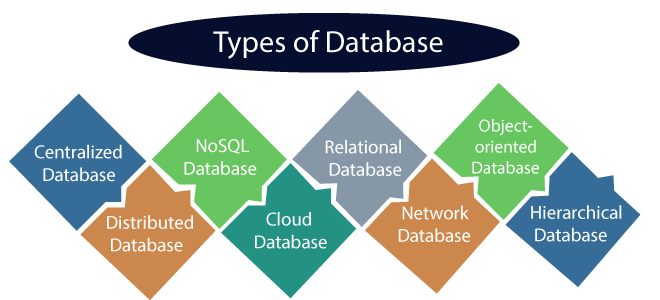
In our increasingly data-saturated world, the ability to efficiently store, manage, and retrieve information is paramount. This is where Database Management Systems (DBMS) come into play, acting as the backbone for countless applications and services we rely on daily. However, the world of DBMS isn't a monolithic entity. There are various architectures and models, each with its own strengths and weaknesses, designed to tackle different data management challenges. Understanding these[ types of DBMS](https://www.tpointtech.com/types-of-databases
) is crucial for anyone working with or even just interacting with technology.
So, let's embark on a journey to explore the fascinating landscape of types of DBMS:
1. Relational Database Management Systems (RDBMS): The Established Powerhouse
Perhaps the most well-known and widely used type of DBMS, RDBMS organizes data into tables with rows and columns. Relationships between these tables are defined through keys, ensuring data integrity and consistency. SQL (Structured Query Language) is the standard language for interacting with RDBMS, allowing for powerful querying and data manipulation.
Key Characteristics:
• Structured Data: Data is organized in a predefined schema.
• Tables and Relationships: Data is stored in related tables.
• SQL: Standard query language for data access and manipulation.
• ACID Properties: Ensures Atomicity, Consistency, Isolation, and Durability of transactions.
• Examples: MySQL, PostgreSQL, Oracle, Microsoft SQL Server.
Best Suited For: Applications requiring structured data, complex relationships, and strong data integrity, such as financial systems, CRM, and ERP.
2. NoSQL Databases: Embracing Flexibility and Scalability
As data volumes exploded and application requirements became more diverse, a new category of types of DBMS emerged: NoSQL (Not Only SQL). These databases deviate from the rigid structure of RDBMS, offering flexibility in data models and often prioritizing scalability and performance for handling large, unstructured, or semi-structured data.
Here are some prominent types of NoSQL DBMS:
• Key-Value Stores: Simple and fast, storing data as key-value pairs. Ideal for caching, session management, and storing user preferences. (e.g., Redis, Memcached).
• Document Databases: Store data as JSON-like documents, offering flexibility in schema and the ability to embed related data within a single document. Well-suited for content management, catalogs, and user profiles (e.g., MongoDB, Couchbase).
• Column-Family Stores: Organize data into columns rather than rows, providing high performance for read-heavy workloads and sparse data. Often used for analytical applications and large-scale data storage (e.g., Cassandra, HBase).
• Graph Databases: Represent data as nodes and edges, focusing on the relationships between data points. Excellent for social networks, recommendation engines, and fraud detection (e.g., Neo4j, Amazon Neptune).
Key Characteristics:
• Schema-less or Flexible Schema: Allows for evolving data structures.
• Scalability: Often designed for horizontal scaling across multiple servers.
• Variety of Data Models: Supports key-value, document, column-family, and graph structures.
• Focus on Performance and Availability: Optimized for specific use cases.
Best Suited For: Applications with high traffic, large data volumes, unstructured or semi-structured data, and specific performance or scalability requirements.
3. Other Notable Types of DBMS:
While RDBMS and NoSQL are the dominant categories, other types of DBMS cater to specific needs:
• Object-Oriented DBMS (OODBMS): Integrates database capabilities with object-oriented programming concepts. While less mainstream now, they were relevant for specific applications.
• Hierarchical DBMS: Organizes data in a tree-like structure with a one-to-many relationship between nodes. An older model, less common today.
• Network DBMS: Allows more complex relationships than hierarchical models, with nodes potentially having multiple parent nodes. Also less prevalent now.
• In-Memory Databases: Store data primarily in RAM for extremely fast access, ideal for real-time analytics and high-performance transaction processing (e.g., SAP HANA).
• Cloud Databases: DBMS offered as a service in the cloud, providing scalability, availability, and managed infrastructure (e.g., Amazon RDS, Google Cloud SQL, Azure SQL Database). These can fall under either RDBMS or NoSQL categories.
Choosing the Right Type of DBMS:
Selecting the appropriate type of DBMS is a critical decision that depends on several factors, including:
• Data Structure: Is your data highly structured, semi-structured, or unstructured?
• Data Relationships: How complex are the relationships between your data points?
• Scalability Requirements: How much data do you anticipate storing and how much traffic will your application handle?
• Performance Needs: What are the read and write performance requirements?
• Consistency and Integrity: How crucial is data consistency and transactional integrity?
• Cost and Complexity: What are the budget and technical expertise available?
In Conclusion:
The world of [types of DBMS](https://www.tpointtech.com/types-of-databases) is diverse and constantly evolving. Understanding the characteristics and use cases of each type empowers developers and data architects to make informed decisions, choosing the right tool for the job. By recognizing the strengths and weaknesses of RDBMS, the flexibility of NoSQL, and the specialized capabilities of other database systems, we can build more efficient, scalable, and robust applications that effectively manage the ever-growing tide of data. So, the next time you interact with an application, remember the intricate world of types of DBMS working silently behind the scenes!
















Write a comment ...